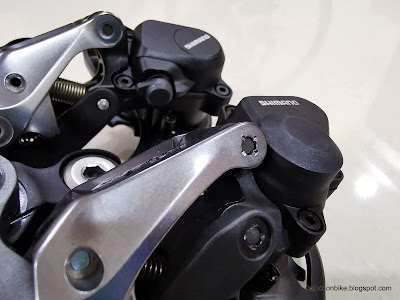The 4 types of GRX rear derailleurs available.
I am using the GRX RD-RX815 Di2 rear derailleur on my Canyon Endurace for gravel riding, and you can read all about it here. Let me just explain briefly what are the differences between these rear derailleurs.
There is a 1x11 and 2x11 speed spec. The 1x11 speed spec has a shorter cage, and a greater slant angle, in order to shift across the wide ratio cassette (up to 42T sprocket). The 1x11 speed spec cannot be used for front double systems, as the chain capacity is insufficient. This 1x11 speed spec is very similar to the MTB version of Di2 rear derailleur (such as Deore XT RD-M8050), as it is used for wide ratio MTB cassettes.
On the other hand, the 2x11 speed spec is quite similar to road rear derailleurs, like the Ultegra RD-R8050. It has a longer cage to cater for the combined chain capacity of the front crankset and rear cassette. However, the max rear sprocket size is limited to 34T, as 1) Not enough chain capacity for larger sprocket, and 2) Shallower slant angle, unable to reach larger 40T or 42T sprocket.
Of course there are those who will try to set up the rear derailleurs beyond these recommended specifications, and they may work, depending on how you adjust it. However, the shifting performance may suffer.
Then, there is the mechanical spec and Di2 spec. All the above information applies to both the mechanical and Di2 spec. In summary, there will be a suitable rear derailleur for you, regardless of whether you use mechanical or Di2 shifting, or whether you are using a front single or front double drivetrain.
Needless to say, all these GRX derailleurs have a clutch system, for chain retention over bumpy terrain. This is the main difference between normal road and these gravel rear derailleurs.
For the detailed comparison below, I will be using the Di2 versions for comparison, the RD-RX815 (2x11 speed Di2 spec) and RD-RX817 (1x11 speed Di2 spec).
RD-RX815 (2x11 speed, longer cage) on the left, and the RD-RX817 (1x11 speed, shorter cage) on the right.
The design language may be similar, but the construction is quite different.
RD-RX817 (right side) has a larger motor, which is from the Deore XT Di2 rear derailleur.
The clutch design also looks different. RX817 on top, RX815 below.
RX815 on the left, with a black clutch lever. RX817 on the right has a grey coloured clutch lever.
RX817 (top) has a rubber cap, which protects the external clutch adjustment screw from dust and dirt. For RX815 (bottom), you have to remove the plastic cover for clutch tension adjustment.
The construction is also quite different. RX817 (top) has a stamped aluminium inner link, while RX815 (bottom) has a resin inner link.
Motor unit and the surrounding link arms are very different as you can see.
The design of the saver unit is also totally different. RX817 on the left, RX815 on the right.
Both have a 11T guide pulley.
RX815 (right) has a longer cage for more chain capacity. Lots of cutouts on the inner plate for weight savings.
RX817 (left) has a 11T tension pulley, while RX815 (right) has a larger 13T tension pulley. This helps to increase chain capacity without further increasing cage length.
RD-RX817 (1x11 speed spec) weighs 321 grams, which is exactly the same as the Deore XT RD-M8050 rear derailleur.
RX-RX815 (2x11 speed spec) is a bit lighter, at 287 grams. However, this is still 90 grams more than the Dura-Ace RD-R9150 that I am using on the Canyon Endurace.
From this comparison, we can see that although both are GRX rear derailleurs, they are fundamentally different. The GRX 1x11 speed rear derailleur is a direct copy of the MTB version of the Di2 clutch rear derailleur, while the 2x11 speed construction is new.















would be cool to pull the clutch covers off to see the differences if any in diameter and friction band
ReplyDeleteThe clutch units are the same, just with slightly different layout.
DeleteDo you think it would work to use the 815 Di2 RD in a 1by setup? I want to change my front rings from 48/31 to a single 40t. What would the limitation of functionality be using the 815 in the back? Does the 817 deal better with yaw angle when in the biggest/smallest cog? I know that the 815 clears a 11-40 xt cassette.
ReplyDelete1x is OK. I have used it up with up to 36T sprocket. With 40T sprocket, the shifting performance is poor when shifting to 11T sprocket.
DeleteIf you are using a cassette larger than 36T, better to use RX817 for the wider range cassette.
My Ultegra RD-6870 worked well with a road link for 4 years, then it got into the wheel, broke off. My setup is 34-50 front and XT 11-40T rear.
DeleteDo you recommend RX815 or RX817 for my setup?
Would I need a road link for both?
I'm lost, sorry.
Thank you.
I experimented with various versions of this, to match a front double crankset to a wide range rear cassette.
Deletehttps://handsonbike.blogspot.com/2020/11/cervelo-aspero-slx-11-40t-cassette.html
I think what will work is to use a RDRX815, for the larger chain capacity. Then, match it with a Wolf Tooth Roadlink DM.
https://handsonbike.blogspot.com/2021/07/focus-paralane-wolf-tooth-roadlink-dm.html